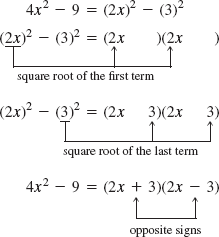11.2. Difference of Two Squares
The next type of expression that we will factor is a binomial in which one square is subtracted from another.
▪ Exploration:
Try this. Multiply (2x + 3) by (2x − 3).
Examine the product you just obtained. How many terms does it have? When you multiply two binomials, do you usually get that number of terms? How are the terms related to those in the two original binomials? Can you express your results in general terms?
An expression of the form

where one perfect square is subtracted from another, is called a difference of two squares. It arises when (a − b) and (a + b) are multiplied together.
NOTE
![]()
This is one example of what is called a special product.
11.2.1. Factoring the Difference of Two Squares
Once we recognize its form, the difference of two squares is easily factored.
Example 8:This example shows how to factor a difference of two squares.
|
Example 9:Here are more examples of the factoring of a difference of two squares.
|
NOTE
There is no similar rule for factoring the sum of two squares, such as
- a2 + b2
TI-89 calculator ...
Get Technical Mathematics, Sixth Edition now with the O’Reilly learning platform.
O’Reilly members experience books, live events, courses curated by job role, and more from O’Reilly and nearly 200 top publishers.


